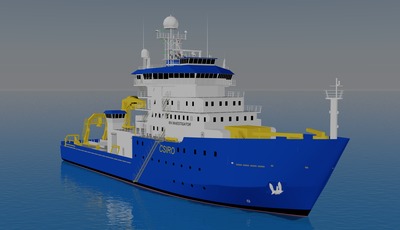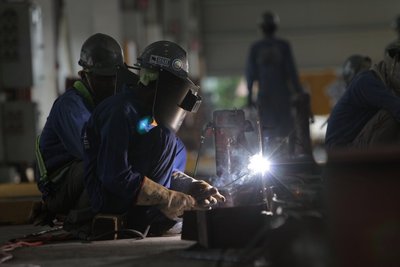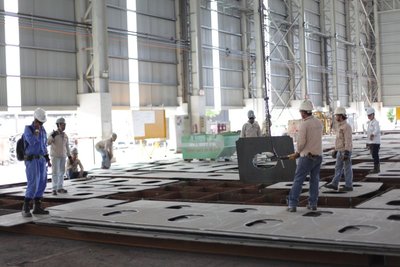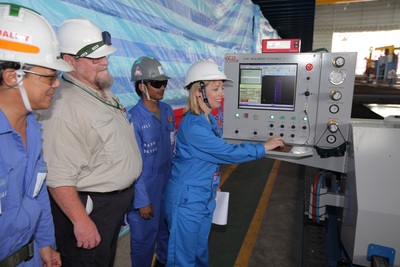Marine research vessel sailing into new waters
Tuesday, 01 May, 2012
For 40 years, the Southern Surveyor - the research vessel of the Marine National Facility - has conducted scientific voyages covering everything from underwater volcanoes to a carbon chemistry map of the Great Barrier Reef. But soon, it will be replaced with a new vessel, one in which the Australian Government has invested $120 million - the RV Investigator.
The Investigator was purchased for the Future Research Vessel Project, launched in 2009 as part of the government’s Super Science Initiative. Like the Southern Surveyor, it will be owned and managed by the CSIRO, which also operates the Marine National Facility. It is hoped that the new vessel will meet the needs and answer the questions of an ever-expanding scientific community - especially those related to climate change - while also providing a more efficient, advanced alternative to the Southern Surveyor. At 93.6 m in length, it will be able to hold more scientists, have longer voyages and be operational for twice as long as its predecessor. It will be capable of operating continuously for 60 days at sea, cruising at 12 knots over a range of 10,000 nautical miles each voyage.
But the Investigator’s own journey has only just begun. Having started construction on 31 January in Singapore, it will not be delivered to Australia until June 2013, at which point 80% of the interior will have been fitted out. The remaining equipment will be fitted here, with some of it to be transferred from the Southern Surveyor. A testing period will then run for the next few months, finishing towards the end of the year.

The vessel will contain scientific equipment worth $20 million, including a core backbone of permanently fitted sampling, data acquisition, management, presentation and communication systems - all of which will be available to any research team using the vessel. Teams will be able to add systems to support their own investigations as well, such as radiation and trace metal laboratories; deep-water dredging, coring and drilling devices; fishing nets; towed camera systems; and remotely operated vehicles.
The vessel will also, for the first time, include a two-tonne Bureau of Meteorology radar and accompanying equipment. It is this which interests Melita Keywood, an atmospheric scientist who works for the CSIRO and Bureau of Meteorology. Keywood has never been on a research vessel before, mainly due to the fact that an Australian vessel has never before had the facilities for atmospheric research. Having this equipment on board will allow her to conduct examinations which were previously only possible on land.
“What’s new about the RV Investigator is that we now have laboratories on the ship that are just really there for us to install our equipment in,” says Keywood. “And also, the way we get the air from the atmosphere into the ship is really important, so we’ve had to design special sampling inlets for that.”

Keywood’s research, which will take her from the Southern Ocean to the Timor Sea and the Great Barrier Reef, will focus on gathering data on the atmosphere of the Southern Hemisphere. She explains, “The Southern Hemisphere is much cleaner than the Northern Hemisphere. We have a lot less sources of pollution in the Southern Hemisphere. Often that means we get ignored. So if you look at climate models, or if you look at observation networks, you’ll see that there’s not a lot of data or information coming from the Southern Hemisphere.
“The main thing that the RV Investigator is going to allow us to do is to make these measurements and to fill up that database of what’s going on in the Southern Hemisphere, so that when people run their climate models for the globe, they have some data they can use.”
Just like any Australian scientist who wants to use the Investigator for research, Keywood had to submit an ‘expression of interest’. The Marine National Facility examines each proposal for its scientific merits, then comes up with a series of destinations for the project’s voyage. Research teams can even ‘piggyback’ with other groups that wish to go to the same area at the same time of the year, as the Investigator can accommodate up to 40 scientists, while the Southern Surveyor could only hold 15.
“It’s going to be pretty rare that you could get 40 people on one project,” says Keywood. “There’s going to be a need to combine several different projects in one voyage.”
Just as the research projects are nominated and selected, so too is the equipment that each party uses. Keywood is a member of the Technical Advisory Group (TAG), whose role is to select this equipment. The TAG does this by approaching each research community and asking them what equipment has to be on the ship in order to provide the data they need. The TAG then comes up with a list of priorities based on these results.

It is clear that the Investigator will have a big impact on Australia’s scientific opportunities. Despite having the third largest ocean territory in the world, Australia is actually under-resourced when it comes to marine research. Keywood explains, “If you compare the territory of water that Australia covers, it’s very similar to Canada. Canada has 17 research vessels like this, and Australia has one. But if you compare somewhere like Belgium, which is very small, they have three vessels. So we’ve actually got fairly minimal resources for the amount of area of sea that surrounds Australia.
“Having said that though, you’ll find that it means we’re a lot more efficient at what we do. A lot of the publications that come out of the research of the Southern Surveyor are top notch, and they’re recognised as some of the best in the world. So I think that we do very very well considering the resources that we have.
“Now the Investigator, in terms of people, and time at sea, is going to triple the amount of material that we can collect and the amount of data we can collect.”
This, claims Keywood, will allow for a more collaborative approach - both interdisciplinary and international.
“You can imagine, the Southern Ocean is very difficult for someone from North America or Europe to get to, so if they can have access to our ship that’s going to be very attractive for them to be involved in our research. And that’ll only make our research even more useful and more high quality.”

So while the RV Investigator’s maiden voyage is still a long way away, Keywood is excited for the role the vessel will play in the world of marine and atmospheric research.
“It’s really opened up the scope for the science that we do in our group at CSIRO,” she says. “I think it’s really an exciting development for us, and hopefully we’ll be able to utilise it in the best possible way and get the most out of it.”
With thanks to Melita Keywood and Sarah Schofield (Communication Officer - CSIRO Marine and Atmospheric Research).
For more information on the RV Investigator, visit http://www.marine.csiro.au/nationalfacility/Investigator/index.htm.
Light pollution promotes blue-green algae growth in lakes
Artificial light at night promotes the proliferation of cyanobacteria, also known as blue-green...
Solar-powered reactor uses CO2 to make sustainable fuel
Researchers have developed a reactor that pulls carbon dioxide directly from the air and converts...
Scientists simulate the effects of an asteroid collision
How would our planet physically react to a future asteroid strike? Researchers simulated an...




